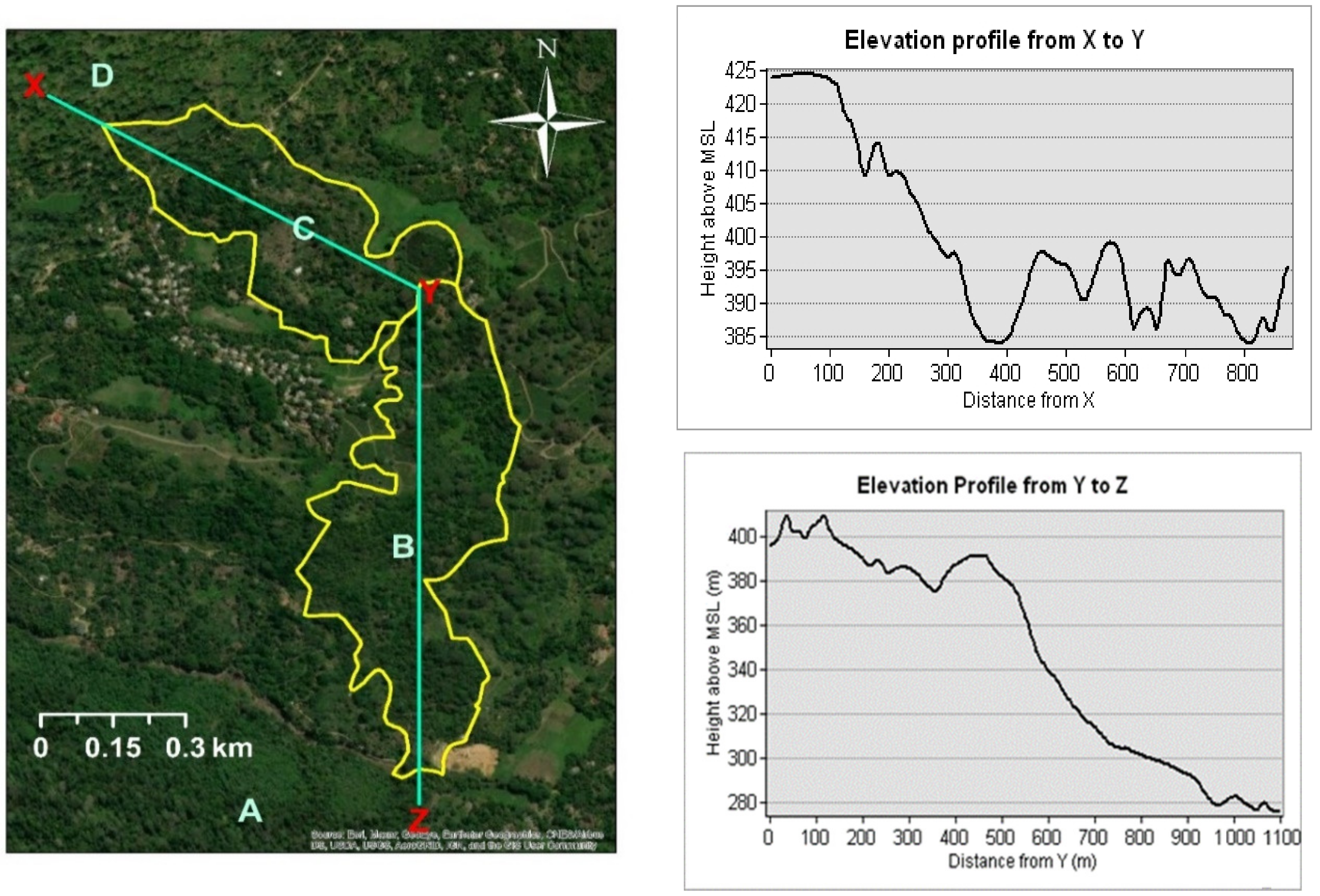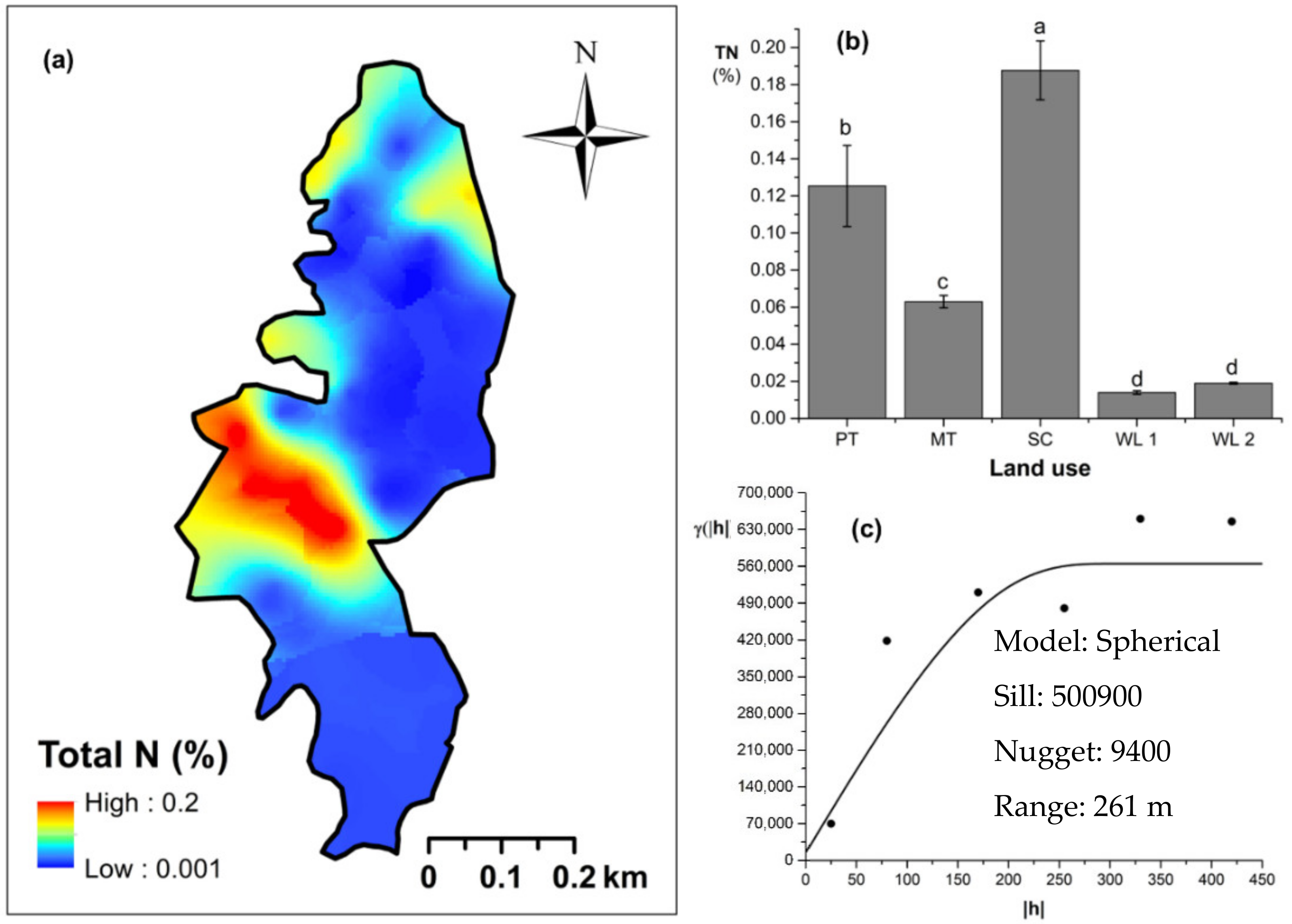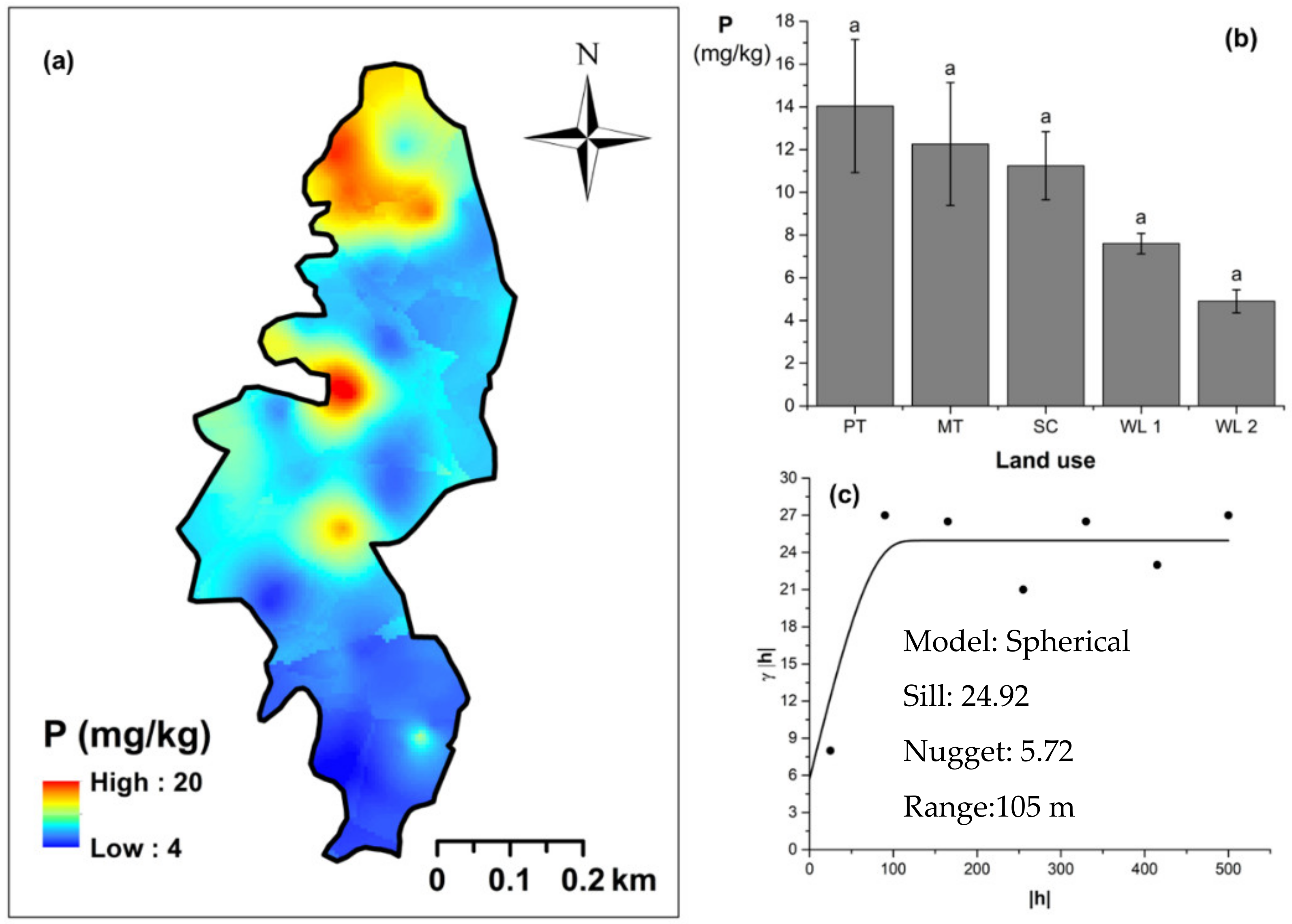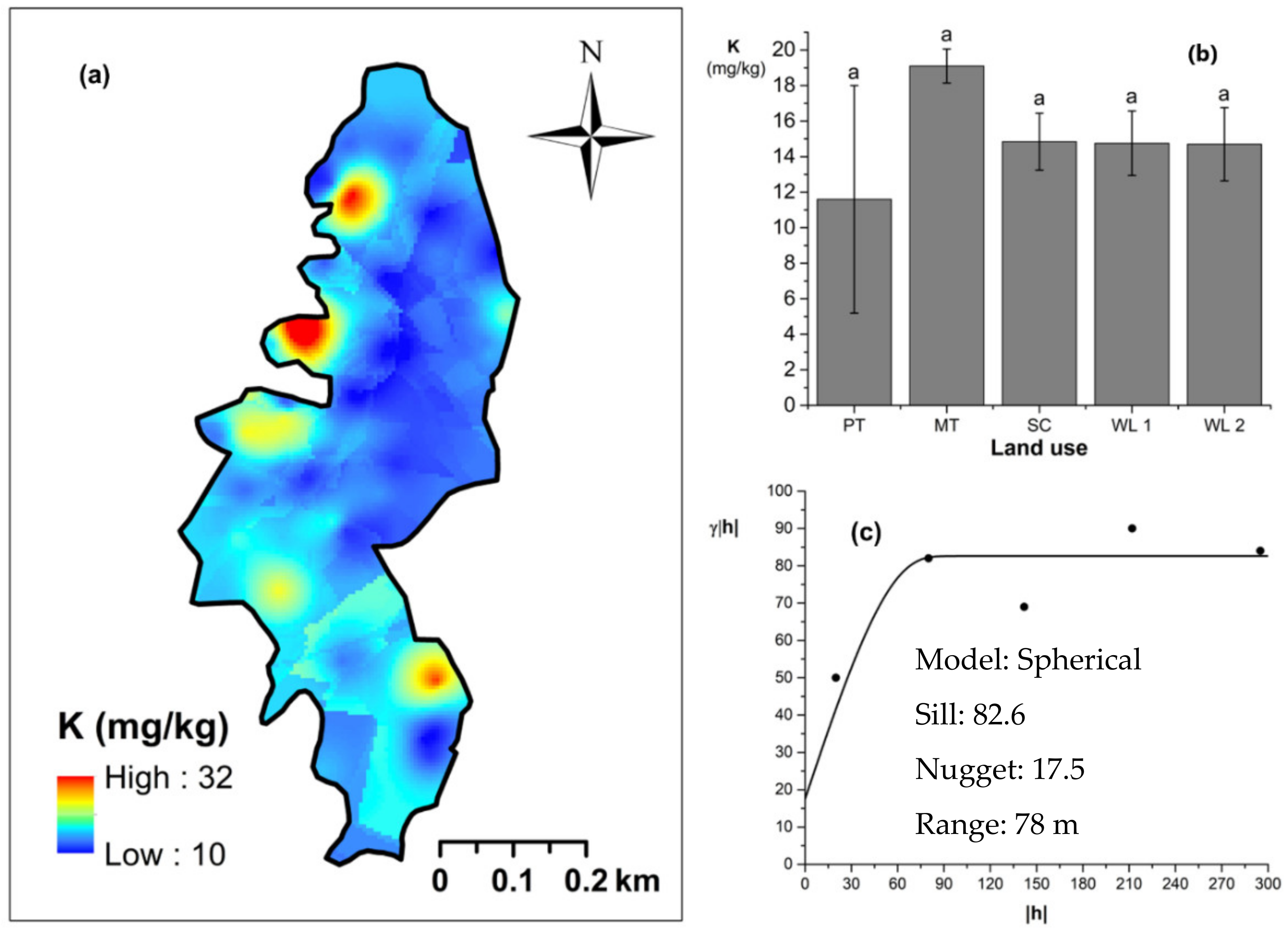Tree Diversity and Soil Characteristics in a Tea–Forest Interface in Southwest Sri Lanka
Abstract
:1. Introduction
2. Materials and Methods
2.1. Study Site
2.2. Study Design
2.3. Floristic Survey and Other Measurements
2.4. Soil Survey and Other Measurements
2.5. Calculations and Data Analysis
3. Results
3.1. Vegetation Analyses in Relation to Land Use Categories
3.2. Spatial Variation in Soil Physical and Chemical Properties
3.3. Vegetation Analysis in Relation to Soil Parameters and Landu Use Categories
4. Discussion
4.1. Restoration of Floristics Diversity, Abovegound Biomass, and Canopy Cover
4.2. Proximity to the Sinharaja Rainforest Complex Facilitates Regeneration
4.3. Land-Use Type and Soil Parameters along the Successional Chrono-Sequence
4.3.1. Soil Total Nitrogen
4.3.2. Soil Exchangeable Potassium
4.3.3. Soil Available Phosphorus
4.3.4. Soil Organic Carbon
4.3.5. Soil pH
4.3.6. Soil Bulk Density
4.3.7. Soil Electrical Conductivity
5. Conclusions and Recommendations
Author Contributions
Funding
Institutional Review Board Statement
Data Availability Statement
Acknowledgments
Conflicts of Interest
Appendix A
| No | Scientific Name | Family | Common Name | Frequency |
|---|---|---|---|---|
| 1 | Symplocos cohinchinensis (Lour.) S. Moore | Symplocaceae | Bombu | 278 |
| 2 | Camellia sinensis (L.) Kuntze | Theaceae | Tea | 171 |
| 3 | Macaranga peltata (Roxb.)Müll.Arg. | Euphorbiaceae | Kenda | 160 |
| 4 | Lantana camara L. | Verbenaceae | Gandapana | 116 |
| 5 | Alstonia macrophylla Wall.ex G.Don | Apocynaceae | Ginikuru | 66 |
| 6 | Litsea longifolia Nees | Lauraceae | Rathkeliya | 58 |
| 7 | Melia azedarach C.DC. | Meliaceae | Lunumidella | 56 |
| 8 | Mallotus tetracoccus Roxb. | Euphorbiaceae | Bu kenda | 47 |
| 9 | Calliandra guildingii Killip & J.F. Macbr | Leguminosae | Calliandra | 44 |
| 10 | Cinnamomum verum (L.) Farw. | Lauraceae | Kurundu | 39 |
| 11 | Psidium guajava L. | Myrtaceae | Pere | 33 |
| 12 | Bridelia retusa (L.) A.Juss. | Euphorbiaceae | Kata kela | 25 |
| 13 | Gliricidia sapium (Jacq.)Walp. | Fabaceae | Wetamara | 22 |
| 14 | Filicium decipiens (Wight & Arn.) Thwaites | Sapindaceae | Pihibiya | 20 |
| 15 | Acacia melanoxylon R.Br | Leguminosae | Acacia | 13 |
| 16 | Albizia odoratissima (L.F.) Benth. | Leguminosae | Albizia | 12 |
| 17 | Chromolaena odorata (L.) R.M.King & H.Rob. | Asteraceae | Podisinghomaran | 12 |
| 18 | Ziziphus oenoplia (L.) Mill. | Rhamnaceae | Heen eraminiya | 12 |
| 19 | Eucalyptus obliqua L ‘Hėr. | Myrtaceae | Eucalyptus | 11 |
| 20 | Alstonia scholaris L. | Apocynaceae | Rukkathtana | 8 |
| 21 | Horsfieldia iryaghedhi (Gaertn.) Warb. | Myristicaceae | Rukkathtana | 8 |
| 22 | Artocarpus nobilis Kuntze | Moraceae | Wal del | 7 |
| 23 | Caryota urens L. | Arecaceae | Kithul | 7 |
| 24 | Syzygium caryophyllatum (L.) Alston | Myrtaceae | Dan | 7 |
| 25 | Artocarpus heterophyllus Lam. | Moraceae | Kos | 6 |
| 26 | Myristica dactyloides Wall. | Myristicaceae | Malabada | 6 |
| 27 | Ficus benghalensis L. | Moraceae | Nuga | 5 |
| 28 | Leea indica (Burm. F.) Merr. | Leeaceae | Burulla | 5 |
| 29 | Artabotrys zelianicus Hook.f.&.Thomson | Annonaceae | Kalu bambara wel | 4 |
| 30 | Elaeocarpus serratus Raf. | Elaeocarpaceae | Weralu | 4 |
| 31 | Ceiba pentandra (L.) Gaertn. | Malvaceae | Pulun kotta | 3 |
| 32 | Ziziphus lucida (L.) Mill. | Rhamnaceae | Yak eraminiya | 3 |
| 33 | Adenanthera pavonina L. | Fabaceae | Madatiya | 2 |
| 34 | Annona squamosa L. | Annonaceae | Katuanoda | 2 |
| 35 | Bambusa sp. | Poaceae | Bata | 2 |
| 36 | Bombax ceiba L. | Malvaceae | Katu ibul | 2 |
| 37 | Mangifera indica L. | Anacardiaceae | Amba | 2 |
| 38 | Osbeckia octandra DC. | Melastomataceae | Bowitiya | 2 |
| 39 | Pagiantha dichotoma (Roxb. Ex Wall.) Markgr. | Apocynaceae | Divi kaduru | 2 |
| 40 | Plumeria obtusa L. | Apocynaceae | Araliya | 2 |
| 41 | Pterospermum suberifolium (L.) Willd | Malvaceae | Welan | 2 |
| 42 | Swietenia macrophylla King | Meliaceae | Mahogani | 2 |
| 43 | Acronychia pedunculata (L.) Miq. | Rutaceae | Ankenda | 1 |
| 44 | Aporusa lindleyana L. | Euphorbiaceae | Kebella | 1 |
| 45 | Ardisia elliptica Thunb. | Myrsinaceae | Balu dan | 1 |
| 46 | Artocarpus altilis (Parkinson ex. F.A.Zorn) Fosbers | Moraceae | Del | 1 |
| 47 | Canthium coromandelicum (Burm.f.)Alston | Rubiaceae | Kara | 1 |
| 48 | Cassine balae Kosterm. | Celastraceae | Neralu | 1 |
| 49 | Cleistocalyx operculatus (Roxb.) Merr. & L.M. Perry | Myrtaceae | Bata damba | 1 |
| 50 | Coffea spp. | Rubiaceae | Copi | 1 |
| 51 | Dillenia spp. L. | Dilleniaceae | Godapara | 1 |
| 52 | Erythrina variegata L. | Fabaceae | Erabadu | 1 |
| 53 | Ficus religiosa L. | Moraceae | Bo | 1 |
| 54 | Gironniera parvifolia Planch. | Ulmaceae | Akmediya | 1 |
| 55 | Gomphia serrata (Gaertn.) Kanis | Ochnaceae | Bo kera | 1 |
| 56 | Lannea coromandelica (Houtt.) Merr. | Anacardiaceae | Hik | 1 |
| 57 | Salacia chinensis L. | Hippocrateaceae | Hibutu | 1 |
| 58 | Schumacheria castaneifolia Vahl | Dilleniaceae | kekiriwara | 1 |
| 59 | Spathodea campanulata L. | Bignoniaceae | Sapodia | 1 |
| 60 | Vitex altissima L.f. | Lamiaceae | Milla | 1 |
| Total | 60 species | 33 families | 1302 |

References
- Food and Agriculture Organization (FAO); UN Environment Programme (UNEP). The State of the World’s Forests 2020: Forests, Biodiversity and People; Food and Agriculture Organization: Rome, Italy, 2020. [Google Scholar]
- Powers, J.S.; Marín-Spiotta, E. Ecosystem Processes and Biogeochemical Cycles in Secondary Tropical Forest Succession. Annu. Rev. Ecol. Evol. Syst. 2017, 48, 497–519. [Google Scholar] [CrossRef] [Green Version]
- Chazdon, R.L.; Harvey, C.A.; Komar, O.; Griffith, D.M.; Ferguson, B.G.; Martínez-Ramos, M.; Morales, H.; Nigh, R.; Soto-Pinto, L.; van Breugel, M.; et al. Beyond Reserves: A Research Agenda for Conserving Biodiversity in Human-modified Tropical Landscapes. Biotropica 2009, 41, 142–153. [Google Scholar] [CrossRef] [Green Version]
- Murawski, D.A.; Dayanandan, B.; Bawa, K.S. Outcrossing Rates of Two Endemic Shorea Species from Sri Lankan Tropical Rainforests. Biotropica 1994, 26, 23. [Google Scholar] [CrossRef]
- Amira, A.; Lippok, D.; Hensen, I.; Schleuning, M.; Both, S.; Apaza-Quevedo, A.; Lippok, D.; Hensen, I.; Schleuning, M.; Both, S. Elevation, Topography, and Edge Effects Drive Functional Composition of Woody Plant Species in Tropical Montane Forests. Biotropica 2015, 47, 449–458. [Google Scholar] [CrossRef]
- Murcia, C. Edge effects in fragmented forests: Implications for conservation. Trends Ecol. Evol. 1995, 10, 58–62. [Google Scholar] [CrossRef]
- Corlett, R.T. Plant diversity in a changing world: Status, trends, and conservation needs. Plant Divers. 2016, 38, 10–16. [Google Scholar] [CrossRef] [Green Version]
- Jayathilake, H.M.; Prescott, G.W.; Carrasco, L.R.; Rao, M.; Symes, W.S. Drivers of deforestation and degradation for 28 tropical conservation landscapes. Ambio 2021, 50, 215–228. [Google Scholar] [CrossRef]
- Thapa, G.B.; Weber, K.E. Actors and Factors of Deforestation in “Tropical Asia”. Environ. Conserv. 1990, 17, 19–27. [Google Scholar] [CrossRef]
- Sudhakar Reddy, C.; Saranya, K.R.L.; Vazeed Pasha, S.; Satish, K.V.; Jha, C.S.; Diwakar, P.G.; Dadhwal, V.K.; Rao, P.V.N.; Krishna Murthy, Y.V.N. Assessment and monitoring of deforestation and forest fragmentation in South Asia since the 1930s. Glob. Planet. Chang. 2018, 161, 132–148. [Google Scholar] [CrossRef]
- Chazdon, R.L. Second Growth: The Promise of Tropical Rainforest Regeneration in the Age of Deforestation; University of Chicago Press: Chicago, IL, USA, 2014. [Google Scholar]
- Teixeira, H.M.; Cardoso, I.M.; Bianchi, F.J.J.A.; da Cruz Silva, A.; Jamme, D.; Peña-Claros, M. Linking vegetation and soil functions during secondary forest succession in the Atlantic forest. For. Ecol. Manag. 2020, 457, 117696. [Google Scholar] [CrossRef]
- Kettle, C.J. Ecological considerations for using dipterocarps for restoration of lowland rainforest in Southeast Asia. Biodivers. Conserv. 2010, 19, 1137–1151. [Google Scholar] [CrossRef]
- Balazs, K.R.; Kramer, A.T.; Munson, S.M.; Talkington, N.; Still, S.; Butterfield, B.J. The right trait in the right place at the right time: Matching traits to environment improves restoration outcomes. Ecol. Appl. 2020, 30, e02110. [Google Scholar] [CrossRef] [Green Version]
- Werner, P. Changes in Soil Properties During Tropical Wet Forest Succession in Costa Rica. Biotropica 1984, 16, 43. [Google Scholar] [CrossRef]
- Guggenberger, G.; Zech, W. Soil organic matter composition under primary forest, pasture, and secondary forest succession, Region Huetar Norte, Costa Rica. For. Ecol. Manag. 1999, 124, 93–104. [Google Scholar] [CrossRef]
- Palmiotto, P.A.; Davies, S.J.; Vogt, K.A.; Ashton, M.S.; Vogt, D.J.; Ashton, P.S. Soil-related habitat specialization in dipterocarp rainforest tree species in Borneo. J. Ecol. 2004, 92, 609–623. [Google Scholar] [CrossRef]
- Townsend, A.R.; Cleveland, C.C.; Asner, G.P.; Bustamante, M.M.C. Controls over foliar n:p ratios in tropical rainforests. Ecology 2007, 88, 107–118. [Google Scholar] [CrossRef]
- Sreekar, R.; Mohan, A.; Das, S.; Agarwal, P.; Vivek, R. Natural Windbreaks Sustain Bird Diversity in a Tea-Dominated Landscape. PLoS ONE 2013, 8, e70379. [Google Scholar] [CrossRef] [PubMed] [Green Version]
- Mapa, R.B.; Somasiri, R.; Nagarajah, S. Soils of the Wet Zone of Sri Lanka. Soils of the Wet Zone of Sri Lanka. Morphology, Characterization and Classification. Special Publication No. 1; Survodaya Publishers: Colombo, Sri Lanka, 1999. [Google Scholar]
- Maheswaran, J.; Gunathilake, I.A.U.N. Nitrogenase Activity in Soil and Litter of a Tropical Lowland Rainforest and an Adjacent Fernland in Sri Lanka. J. Trop. Ecol. 2016, 6, 281–289. [Google Scholar] [CrossRef]
- Ashton, M.S. A Field Guide to the Common Trees and Shrubs of Sri Lanka; WHT Publication (Pvt.) Limited: Colombo, Sri Lanka, 1997. [Google Scholar]
- Gartley, K. Recommended Methods for Measuring Soluble Salts in Soils; University of Delaware Extension: Newark, NJ, USA, 1982; pp. 87–94. [Google Scholar]
- Nelson, D.W.; Sommers, L.E. Total carbon, organic carbon, and organic matter. In Methods of Soil Analysis, Part 2; Miller, R.H., Keeney, D.R., Eds.; Soil Science Society of America (SSSA): Madison, WI, USA, 1982; pp. 539–579. [Google Scholar]
- Nelson, D.W.; Sommers, L.E. A Simple Digestion Procedure for Estimation of Total Nitrogen in Soils and Sediments1. J. Environ. Qual. 1972, 1, 423. [Google Scholar] [CrossRef]
- Jackson, M.L. Soil Chemical Analysis; Prentice Hall: London, UK, 1958. [Google Scholar]
- Murphy, J.; Riley, J.R. A Modified Single Solution Method for the Determination of Phosphate. Anal. Chim. Acta 2002, 27, 31–36. [Google Scholar] [CrossRef]
- Blake, G.R.; Hartge, K.H. Bulk density. In Methods of Soil Analysis: Part 1. Physical and Mineralogical Method, Agronomy Monograph 9; Klute, A., Ed.; American Society of Agronomy: Madison, WI, USA; Soil Science Society of America: Madison, WI, USA, 1986; pp. 363–375. [Google Scholar]
- Chave, J.; Maxime, R.-M.; Búrquez, A.; Chidumayo, E.; Colgan, M.S.; Delitti, W.B.C.; Duque, A.; Eid, T.; Fearnside, P.M.; Goodman, R.C.; et al. Improved allometric models to estimate the aboveground biomass of tropical trees. Glob. Chang. Biol. 2014, 20, 3177–3190. [Google Scholar] [CrossRef]
- Cambardella, C.A.; Moorman, T.B.; Novak, J.M.; Parkin, T.B.; Karlen, D.L.; Turco, R.F.; Konopka, A.E. Field-scale Variability of Soil Properties in Central Lowa Soils. Soil Sci. Soc. Am. J. 1994, 53, 800–805. [Google Scholar]
- Issaaks, E.H.; Srivastava, R.M. Applied Geostatistics; Oxford University Press: New York, NY, USA, 1989. [Google Scholar]
- Connell, J.H. Diversity in tropical rainforests and coral reefs. Science 1978, 199, 1302–1310. [Google Scholar] [CrossRef] [Green Version]
- Grime, J.P. Competitive exclusion in herbaceous vegetation. Nature 1973, 242, 344–347. [Google Scholar] [CrossRef]
- Wilkinson, D.M. The Disturbing History of Intermediate Disturbance. Oikos 1999, 84, 145. [Google Scholar] [CrossRef] [Green Version]
- Shea, K.; Roxburgh, S.H.; Rauschert, E.S.J. Moving from pattern to process: Coexistence mechanisms under intermediate disturbance regimes. Ecol. Lett. 2004, 7, 491–508. [Google Scholar] [CrossRef]
- Wijesooriya, W.A.D.A.; Gunatilleke, C.V.S. Buffer zone of the Sinharaja Biosphere Reserve in Sri Lanka and its management strategies. J. Natl. Sci. Found. Sri Lanka 2003, 31, 57. [Google Scholar] [CrossRef]
- Lindström, S.; Mattsson, E.; Nissanka, S.P. Forest cover change in Sri Lanka: The role of small scale farmers. Appl. Geogr. 2012, 34, 680–692. [Google Scholar] [CrossRef]
- Chazdon, R.L.; Fetcher, N. Photosynthetic Light Environments in a Lowland Tropical Rainforest in Costa Rica. J. Ecol. 1984, 72, 553. [Google Scholar] [CrossRef]
- Sreekumar, V.; Hussain, K.; Renuka, C. Virtual Herbarium of Kerala forest Research Institute, Peechi, Kerala, India. Curr. Sci. 2017, 112, 466–470. [Google Scholar] [CrossRef]
- Ashton, M.S.; Gunatilleke, C.V.S.; Gunatilleke, I.A.U.N.; Singhakumara, B.M.P.; Gamage, S.; Shibayama, T.; Tomimura, C. Restoration of rainforest beneath pine plantations: A relay floristic model with special application to tropical South Asia. For. Ecol. Manag. 2014, 329, 351–359. [Google Scholar] [CrossRef]
- Cohen, A.L.; Singhakumara, B.M.P.; Ashton, P.M.S. Releasing Rainforest Succession: A Case Study in the Dicranopteris linearis Fernlands of Sri Lanka. Restor. Ecol. 1995, 3, 261–270. [Google Scholar] [CrossRef]
- Egler, F.E. Vegetation science concepts I. Initial floristic composition, a factor in old-field vegetation development with 2 figs. Veg. Acta Geobot. 1954, 4, 412–417. [Google Scholar] [CrossRef]
- Chave, J.; Condit, R.; Muller-Landau, H.C.; Thomas, S.C.; Ashton, P.S.; Bunyavejchewin, S.; Co, L.L.; Dattaraja, H.S.; Davies, S.J.; Esufali, S.; et al. Assessing Evidence for a Pervasive Alteration in Tropical Tree Communities. PLoS Biol. 2008, 6, e45. [Google Scholar] [CrossRef]
- Osuri, A.M.; Kasinathan, S.; Siddhartha, M.K.; Mudappa, D.; Raman, T.R.S. Effects of restoration on tree communities and carbon storage in rainforest fragments of the Western Ghats, India. Ecosphere 2019, 10, e02860. [Google Scholar] [CrossRef]
- Chapman, C.A.; Chapman, L.J. Forest Restoration in Abandoned Agricultural Land: A Case Study from East Africa. Conserv. Biol. 1999, 13, 1301–1311. [Google Scholar] [CrossRef]
- Shono, K.; Cadaweng, E.A.; Durst, P.B. Application of Assisted Natural Regeneration to Restore Degraded Tropical Forestlands. Restor. Ecol. 2007, 15, 620–626. [Google Scholar] [CrossRef]
- Gallardo, A.; Paramá, R. Spatial variability of soil elements in two plant communities of NW Spain. Geoderma 2007, 139, 199–208. [Google Scholar] [CrossRef]
- Warrick, A.W.; Nielsen, D.R. Spatial Variability of Soil Physical Properties in the Field. In Applications of Soil Physics; Hillel, D., Ed.; Academic Press: New York, NY, USA, 1980; pp. 319–344. [Google Scholar]
- Goovaerts, P. Geostatistics for Natural Resources Evaluation; Oxford University Press: New York, NY, USA, 1997. [Google Scholar]
- Mc Bratney, A.B.; Webster, R. Choosing functions for semi-variograms of soil properties and fitting them to sampling estimates. Eur. J. Soil Sci. 1986, 37, 617–639. [Google Scholar] [CrossRef]
- Martínez-Yrízar, A. Biomass distribution and primary productivity of tropical dry forests. In Seasonally Dry Tropical Forests; Bullock, S.H., Mooney, H.A., Medina, E., Eds.; Cambridge University Press: Cambridge, MA, USA, 2010; pp. 326–345. [Google Scholar]
- Vitousek, P.M.; Melillo, J.M. Nitrate Losses from Disturbed Forests: Patterns AND Mechanisms. For. Sci. 1979, 25, 605–619. [Google Scholar]
- Birch, H.F. The effect of soil drying on humus decomposition and nitrogen availability. Plant Soil 1958, 10, 9–31. [Google Scholar] [CrossRef]
- Gilliam, F.S.; Adams, M.B. Effects of Nitrogen on Temporal and Spatial Patterns of Nitrate in Streams and Soil Solution of a Central Hardwood Forest. ISRN Ecol. 2011, 2011, 1–9. [Google Scholar] [CrossRef] [Green Version]
- Johnson, D.W.; Cheng, W.; Burke, I.C. Biotic and Abiotic Nitrogen Retention in a Variety of Forest Soils. Soil Sci. Soc. Am. J. 2000, 64, 1503–1514. [Google Scholar] [CrossRef] [Green Version]
- Tan, K.H. Principles of Soil Chemistry; CRC Press: Boca Raton, FL, USA, 2011. [Google Scholar]
- Rao, C.; Srinivas, K. Potassium Dynamics and Role of Non-exchangeable Potassium in Crop Nutrition. Indian J. Fertil. 2017, 13, 80–94. [Google Scholar]
- Jones, J.B., Jr. Plant Nutrition and Soil Fertility Manual; CRC Press: Boca Raton, FL, USA, 2012. [Google Scholar]
- Campo, J.; Maass, M.; Jaramillo, V.J.; Martínez-Yrízar, A.; Sarukhán, J. Phosphorus cycling in a Mexican tropical dry forest ecosystem. Biogeochemistry 2001, 53, 161–179. [Google Scholar] [CrossRef]
- Yang, X.; Thornton, P.E.; Ricciuto, D.M.; Post, W.M. The role of phosphorus dynamics in tropical forests—A modeling study using CLM-CNP. Biogeosciences 2014, 11, 1667–1681. [Google Scholar] [CrossRef] [Green Version]
- Aragão, L.E.O.C.; Malhi, Y.; Metcalfe, D.B.; Silva-Espejo, J.E.; Jiménez, E.; Navarrete, D.; Almeida, S.; Costa, A.C.L.; Salinas, N.; Phillips, O.L.; et al. Above- and below-ground net primary productivity across ten Amazonian forests on contrasting soils. Biogeosciences 2009, 6, 2759–2778. [Google Scholar] [CrossRef] [Green Version]
- Crews, T.E.; Farrington, H.; Vitousek, P.M. Changes in asymbiotic, heterotrophic nitrogen fixation on leaf litter of Metrosideros polymorpha with long-term ecosystem development in Hawaii. Ecosystems 2000, 3, 386–395. [Google Scholar] [CrossRef]
- Edwards, E.J.; McCaffery, S.; Evans, J.R. Phosphorus availability and elevated CO2 affect biological nitrogen fixation and nutrient fluxes in a clover-dominated sward. New Phytol. 2006, 169, 157–167. [Google Scholar] [CrossRef]
- Dalling, J.W.; Heineman, K.; Lopez, O.R.; Wright, S.J.; Turner, B.L. Nutrient Availability in Tropical Rainforests: The Paradigm of Phosphorus Limitation; Springer: Cham, Switzerland, 2016; pp. 261–273. [Google Scholar]
- Osman, K.T. Forest Soils: Properties and Management; Springer: Cham, Switzerland, 2013; Volume 9783319025414, ISBN 9783319025414. [Google Scholar]
- Pribyl, D.W. A critical review of the conventional SOC to SOM conversion factor. Geoderma 2010, 156, 75–83. [Google Scholar] [CrossRef]
- Dissanayaka, S.T.B.; Wijewardena, J.D.H.; Samarappuli, L. Management of the Wet Zone Soil. In Soils of the Wet Zone of Sri Lanka; Special Publication No. 1.; Mapa, R.B., Somasiri, S., Nagarajah, S., Eds.; Soil Science Society of Sri Lanka: Peradeniya, Sri Lanka, 1999; pp. 160–176. [Google Scholar]
- Liyanage, L.R.M.C.; Jayakody, A.N.; Wijayatunga, W.M.S.; Gunaratne, G.P. Feasibility of using soil pH buffering capacity for dolomite recommendation for tea growing soils in Sri Lanka. Sri Lanka J. Tea Sci. 2012, 77, 57–69. [Google Scholar]
- Hillel, D. Introductions to Environmental Soil Physics; Academic Press: San Diego, CA, USA, 2004. [Google Scholar]
- Weil, R.R.; Brady, N.C. The Nature and Properties of Soils, 15th ed.; Prentice Hall: Upper Saddle River, NJ, USA,, 2017. [Google Scholar]
- USDA NRCS. Soil Bulk Density/Moisture/Aeration; United States Department of Agriculture, National Agricultural Statistical Service: Washington, DC, USA, 2014.
- Smith, J.L.; Doran, J.W. Measurement and Use of pH and Electrical Conductivity for Soil Quality Analysis. In Methods for Assessing Soil Quality; Doran, J.W., Jones, A.J., Eds.; John Wiley & Sons: Madison, WI, USA, 1997; pp. 169–185. [Google Scholar]











| Parameter | PT | MT | SC | WD1 | WD2 |
|---|---|---|---|---|---|
| Shannon index | 0.86 ± 0.11 a | 0.38 ± 0.08 a | 1.93 ± 0.07 b | 2.02 ± 0.04 b | 2.09 ± 0.05 b |
| Species richness | 2.8 ± 1.3 a | 2.8 ± 1.3 a | 10.2 ± 2.2 b | 12.3 ± 2.1 b | 14.0 ± 2.9 b |
| Pielou’s evenness | 0.37 a | 0.84 b | 0.83 b | 0.80 b | 0.79 b |
| Stand density (#/ha) | 190 ± 49 a | 120 ± 20 b | 1545 ± 214 b | 1442 ± 41 bc | 1279 ± 67 c |
| AGB (Mg/ha) | 22.22 ± 5.68 a | 12.58 ± 3.48 a | 21.20 ± 1.70 a | 106.74 ± 4.50 b | 56.40 ± 3.13 a |
| Canopy cover | 0 ± 0 a | 21.14 ± 4.22 a | 74.74 ± 14.94 b | 74.77 ± 7.47 b | 72.28 ± 12.04 b |
| Variable | Mean | SD | Min | Max | CV% |
|---|---|---|---|---|---|
| TN (%) | 0.065 | 0.069 | 0.007 | 0.228 | 106.1 |
| Av. P (mg/kg) | 10.0 | 5.3 | 3.1 | 23.4 | 53.0 |
| Ex. K (mg/kg) | 15.8 | 8.4 | 6.5 | 47.9 | 53.0 |
| OC (%) | 1.44 | 0.55 | 0.35 | 2.7 | 38.2 |
| EC (mS/cm) | 29.10 | 18.72 | 14.27 | 147.40 | 64.3 |
| BD (Mg/m3) | 1.48 | 0.31 | 0.82 | 1.88 | 20.9 |
| pH | 5.17 | 0.46 | 4.14 | 6.53 | 9 |
Publisher’s Note: MDPI stays neutral with regard to jurisdictional claims in published maps and institutional affiliations. |
© 2021 by the authors. Licensee MDPI, Basel, Switzerland. This article is an open access article distributed under the terms and conditions of the Creative Commons Attribution (CC BY) license (https://creativecommons.org/licenses/by/4.0/).
Share and Cite
Geekiyanage, N.; Rathnayaka, S.; Gamage, S.; Sandamali, A.A.D.; Nanayakkara, S.; Duminda, D.M.S.; Gunatilleke, S.; Gunatilleke, N. Tree Diversity and Soil Characteristics in a Tea–Forest Interface in Southwest Sri Lanka. Forests 2021, 12, 1506. https://doi.org/10.3390/f12111506
Geekiyanage N, Rathnayaka S, Gamage S, Sandamali AAD, Nanayakkara S, Duminda DMS, Gunatilleke S, Gunatilleke N. Tree Diversity and Soil Characteristics in a Tea–Forest Interface in Southwest Sri Lanka. Forests. 2021; 12(11):1506. https://doi.org/10.3390/f12111506
Chicago/Turabian StyleGeekiyanage, Nalaka, Srimal Rathnayaka, Sriyani Gamage, Adikari Appuhamilage Dulanjala Sandamali, Shamodi Nanayakkara, Don Menige Sudesh Duminda, Savitri Gunatilleke, and Nimal Gunatilleke. 2021. "Tree Diversity and Soil Characteristics in a Tea–Forest Interface in Southwest Sri Lanka" Forests 12, no. 11: 1506. https://doi.org/10.3390/f12111506






